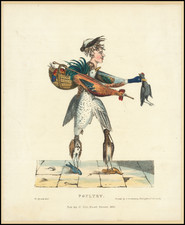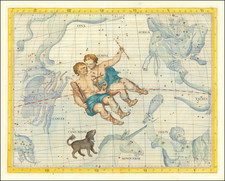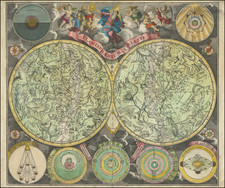Competing Visions of the Solar System
Finely-colored example of Zurner's illustration of Brahe's and Copernicus' models of the solar system.
The two circular diagrams both illustrate heliocentric hypotheses. However, Brahe's shows the planets orbiting the sun, with the sun and moon then orbiting the Earth. Copernicus' model is more familiar, yet it still has the orbits in a circular, rather than an elliptical, shape.
Separating the two models are illustrations of a solar and lunar eclipse.
Modelling the solar system to 1700
Humans have watched the stars for hundreds of thousands of years and they have postulated many models for the make-up of the heavens and, in particular, of the solar system. Cave paintings reveal knowledge of the equinoxes and solstices dating to more than 30,000 years ago. Ancient Babylonians thought the world revolved around the Earth and used their lunar observations to plot a calendar with twelve months.
The Greeks were especially interested in discerning the order and shape of the cosmos. Parmenides claimed that the solar system was spherical. Anaxagoras made the observation that the moon is likely closer to Earth than the sun. Pythagoras and his followers thought that the moon and other planets likely orbited the Earth, with the Earth itself orbiting a larger fire at the center of the universe.
Other astronomers, like Aristotle, also assumed that the solar system was Earth-centric, with the planets and sun tracing orbits around humanity’s home. Plato thought the Earth was the center, with stars in an outer ring radiating from the Earth. Within the star shell were the orbits of the planets, moon, and sun.
Ptolemy agreed that the system must be geocentric and theorized epicycles, or orbits within larger orbits, to explain planetary motion as seen from Earth. To him, Earth was surrounded by the moon, Mercury, Venus, the sun, Mars, Jupiter, and Saturn in concentric circles.
However, inconsistencies and questions remained with Ptolemy’s model. Medieval Islamic astronomers continued to embrace a geocentric theory but combined more precise observations with corrections to try to explain away the issues with a geocentric solar system, including that the motion of the planets did not trace a steady, perfectly circular orbit around the Earth.
In the sixteenth century, Nicolas Copernicus (b. 1473) re-examined the issue of orbits. He thought the planets did orbit in perfectly uniform circles, despite the observation of complex retrograde motion that had flummoxed astronomers for centuries. His massive intervention, however, was to place the sun at the center of the system, not the Earth.
The heliocentric model better explained the varying brightness of the planets, but it also met with resistance from those who had trouble believing that God had not placed humans at the center of the known universe. The controversial nature of the work made Copernicus delay publishing for thirty years; his book, De revolutionibus orbium coelestium, only appeared in 1543, the same year he died.
Tycho Brahe (b. 1546) collected firsthand observations for years, leading him to believe in the changeability of the stars, rather than their fixity as had previously been accepted. Brahe came up with a new model wherein the planets orbited the sun, but the moon and sun orbited the Earth. This allowed for the orbits of planets to cross with that of the sun, which resolved the problem of stellar parallax.
Johannes Kepler (b. 1571) was an advocate of the heliocentric hypothesis, but he used his teacher, Brahe’s, observations to posit a slightly different configuration than Copernicus or Brahe. Rather than place the sun at exactly the center of the solar system, Kepler thought it was actually off to one side, at one of the two foci of an elliptic orbit. He posited that the planets orbit the sun in elliptical (not circular) orbits, that the radius vector joining the planet and the Sun has an equal area in equal periods, and that the square of the period of the planet (one revolution around the sun) is proportional to the cube of the average distance from the sun. This eliminated the need for epicycles—Ptolemy’s circles within circles—and better accounted for the observed movement of the planets.
These laws of planetary motion were confirmed by Galileo Galilei (b. 1564) when he performed observations with a telescope. Galileo also observed the largest of Jupiter’s moons, Io, Europa, Ganymede, and Callisto.
Finally, Isaac Newton (b. 1642) was able to postulate why the planets orbited the sun. With his law of universal gravitation, Newton explained that any two masses have an attractive force between then proportional to the inverse of the distance squared. This formula allowed for the calculation of the force exerted on each planet by the sun, which pulled the planets into elliptical orbit.
Adam Friedrich Zürner (15 August 1679 – 18 December 1742) was a German Protestant priest, cartographer and the head of construction of the Kursächsische Postmeilensäulen in Saxony.
Zurner's first project of note was a map of Saxony, for which he was retained by August III, King of Poland, in 1711.
Zurner was appointed Geographer of Poland and the Electorate of Saxony, a position in which he served until 1732. In this time period, he reportedly traveled nearly 18,000 miles and created over 900 maps.
In 1721, he was tasked with establishing a postal road system in Saxony and marking the distances with stone posts.
His work resulted in the Atlas Augusteus Sauronicus (40 maps plus key sheet), which remained incomplete until after Zurner's death, but was ultimately sold to Pieter Schenk in Amsterdam in about 1745. Schenk's completed work (49 maps, published in Amsterdam and Leipzig) was issued without reference to Zurner's name, under the title Atlas Saxonicus.
Despite his prolific work product, none of Zurner's original manuscript maps seem to survive.
Johann Christoph Weigel (1654-1725), sometimes known as Christop Weigel the Elder, was a notable German engraver, art dealer, and publisher, renowned for his contributions to the fields of cartography and illustration during the late 17th and early 18th centuries. Born in 1654 in the city of Redwitz, in the Margraviate of Bayreuth, Weigel embarked on a career that would place him among the prominent figures in the world of European printmaking.
Weigel's early life and training are somewhat obscure, but it is known that he was active in Nuremberg, a city renowned for its vibrant artistic and cultural scene. Nuremberg was a hub for artists, craftsmen, and publishers, and it was here that Weigel honed his skills and established his reputation. He married the daughter of the prominent engraver and publisher Johann Christoph Lochner, which further integrated him into the thriving artistic community of Nuremberg.
His work encompassed various subjects, including maps, historical scenes, portraits, and scientific illustrations. Weigel's maps are particularly notable for their detail and accuracy, reflecting the growing interest in geography and exploration during his time. His cartographic works often combined practical utility with artistic embellishment, making them valuable for both navigational purposes and as works of art.
One of Weigel's significant contributions was his involvement in the production of the Atlas scholasticus et itinerarius, a comprehensive world atlas that was widely used in educational settings. This work demonstrated his skill in synthesizing geographical information into accessible and informative maps.
In addition to his cartographic endeavors, Weigel produced a vast array of illustrations for books on various subjects, ranging from history to natural science. His illustrations were known for their clarity and detail, contributing to the dissemination of knowledge in an era when visual representations were crucial for understanding complex ideas.
Weigel's legacy is that of a versatile and skilled engraver and publisher who contributed significantly to the visual culture of his time. His works provided practical information and reflected the late Baroque period's intellectual and artistic currents. Christoph Weigel passed away in 1725, leaving behind a body of work that continues to be appreciated for its artistic merit and historical value.









![[Cambodia] Defend the People's Victory | Support the Khmer Rouge & the PRG](https://storage.googleapis.com/raremaps/img/small/85958.jpg)




![(Ortelius ALS) [Autograph letter signed to his nephew Jacob Cole (Jacobus Colius), Antwerp, April 3, 1597.]](https://storage.googleapis.com/raremaps/img/small/98890.jpg)